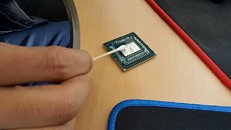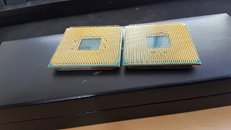Tuesday, November 29th 2016

AMD Socket AM4 "Bristol Ridge" APU De-lidded
Here are some of the first pictures of an AMD socket AM4 APU being de-lidded. De-lidding is the process of removing the IHS (integrated heatspreader), the metal plate covering the CPU die. Some PC enthusiasts remove the IHS to improve heat-transfer between the CPU and extreme cooling solutions, such as LN2/dry-ice evaporators. Overclocker Nam Dae Won, with access to a couple of socket AM4 chips (most likely 7th generation A-series "Bristol Ridge" APUs), de-lidded the chips, revealing a large rectangular die. AMD is using high-quality TIM between the die and the IHS, which could either be solder or liquid metal. There's also a clear picture of the underside pin-grid of the AM4 chip, which has a central cutout that lacks any SMT components. Socket AM4 has 1,331 pins.
Sources:
Nam Dae Won (Facebook page), PCGH





24 Comments on AMD Socket AM4 "Bristol Ridge" APU De-lidded
Like why dont they standard come with something like this instead:
www.pcper.com/files/imagecache/article_max_width/review/2014-06-16/26-die-guard-top.jpg
Where the CPU is exposed for the best contact with the cooler.
Or atleast have some "extreme" edition be like that, it would make sense.
Also why do these still have actual pins pins and not those ermm dots that Intel uses for a while now, seems much more prone to damage with actual pins.
Only recently has the IHS been any kind of hindrance, what with Intel skimping on the internal TIM.
CPU's on other hand are handle by butterfingered users who install it by themselves, there are bunch of different coolers with different contact plates (direct or distributed, flat or slightly curved etc) and different weights. Anyone who has worked with naked cores back in the days knows how fragile thy are and how quickly you can chip edges of the core away. When you're attaching 1kg of metal to it, it can such hard if you crack a 400€ CPU and make it useless. IHS prevents chipping the core, distributes the applied force and is in general a good all around thing for the masses.
Watch this video if your still unsure
I'm really excited to see what zen can actually do, it gets more and more promising with each snippet of info.
Zen must be doing something right? OCable dual core w HT, mainstream hexcore and 32/64 on the server side from Intel now. I can't wait :D
- The die is soldered on just like every CPU since Athlon 64 (though it looks to be applied in two parts in this case).
- He killed the CPU in the process if I read his facebook translation right.
Nam Dae Won is "namegt" around the forums and HWBOT.
To reply to the user that said a vice method is better, that is impossible on AMD CPUs due to the SMT components on the top of the PCB which are the same height or taller than the die. Hint: If you cut past the bonding rubber, they break off easily.
It did had advantages on cooling but the weakest part is that cores could be crushed upon bad installation of the cooler. Another issue was that cores where able to burn up when the cooler was'nt properly attached. You can actually see on above picture that this core has slight damage on corners of chip.
The IHS protects the CPU from being damaged by improper installation. A question in the past was often which thermal compound, solder or whatever was sitting in between the IHS & core. Intel for example used poorly thermal compound which weared out over time. With this, i'm pretty sure AMD and users are able to cool the chip as best as possible since there's almost no loss in cooling capacity.
And regarding LGA and PGA, well all have negatives and positives... I do have an LGA 1155 motherboard with i5 3570K, unfortunately I don't know how and when I saw two pins in the CPU sockets are bent... and It's not cool at all... I knew that from over 1.5 years now and finally knew why I couldn't run the RAM in Dual Channel, and why the CPU is not stable at any rise in clock speed when I was thinking I had a faulty mobo...
These things are damn small and very hard to figure out how they're bent actually to see how you can fix them, you can't actually "see" the wrong thing you just see different reflection pattern, you need a macro lens just to be able to see clear... I already have a macro lens but I still don't have time to check, you know I have to remove the motherboard from the case.. it's not just a removable CPU anymore...